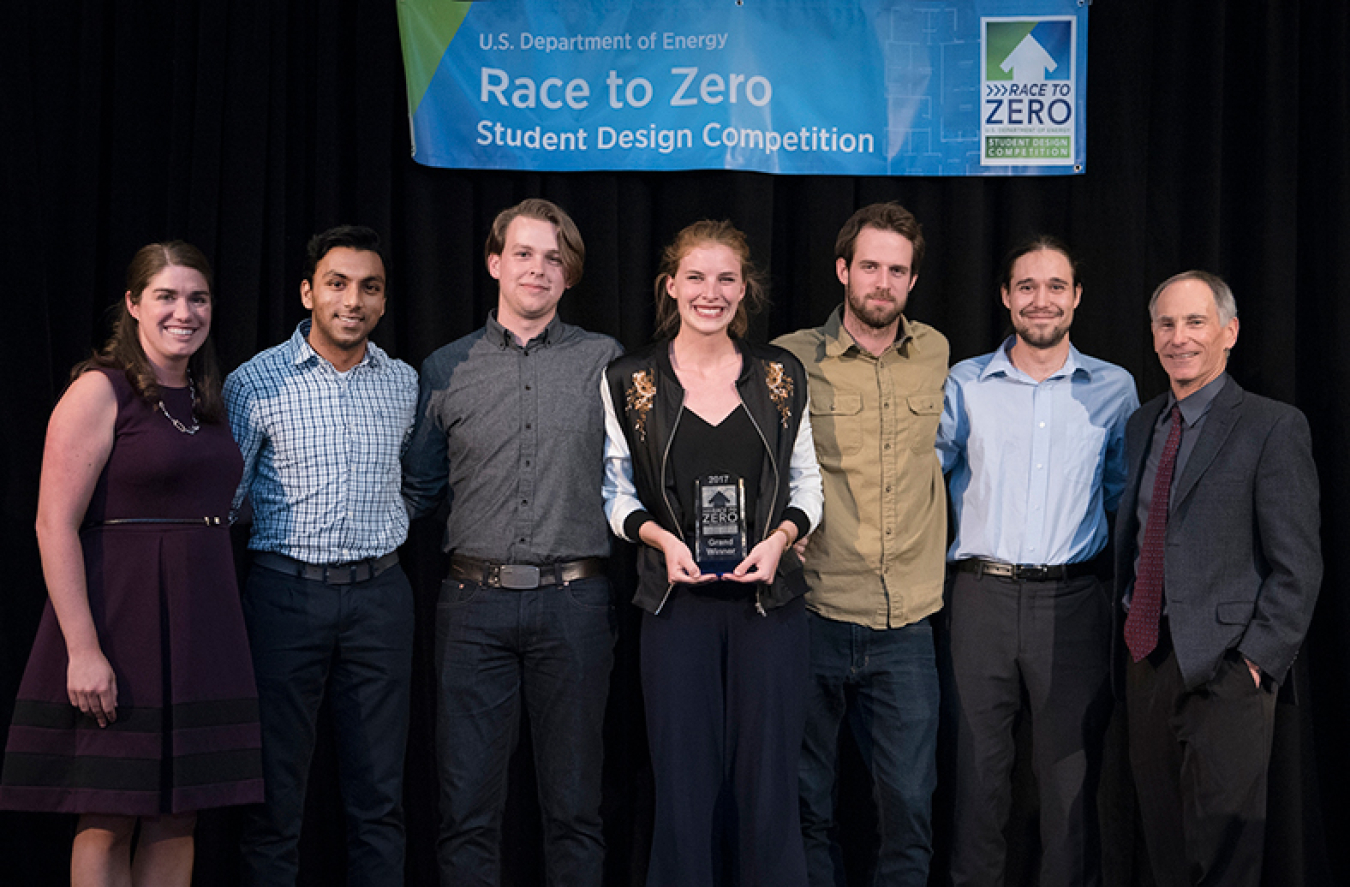Building America Update: Race to Zero, JUMP, and Upcoming Webinars
Welcome to the Building America Update, a monthly newsletter. Read this month's feature story, or select the other newsletter topics below for more information. Subscribe to receive the email version of Building America Update or browse newsletter archives.
Race to Zero Winners Announced

2017 Race to Zero Grand Winners Ryerson University and University of Toronto.
This year's competition featured 39 teams from 33 collegiate institutions and four countries. A zero energy ready home is a high-performance home that is so energy efficient it can offset all or most of its annual energy consumption with renewable energy. This significantly reduces a home's annual energy costs while improving comfort, health, safety, and durability. The U.S. Department of Energy (DOE) announced winners of its fourth annual Race to Zero Student Design Competition, a collegiate competition engaging university students to design zero energy ready homes. The Ryerson University and University of Toronto team from Canada was the grand winner this year.
The competition was held at the National Renewable Energy Laboratory in Golden, Colorado, April 22–23, with the intention to inspire next-generation architects, engineers, and construction managers to apply the latest building science innovations in new and existing homes. The awards recognize students who excel at integrating solid building science principles into designs for zero energy ready homes, including creative solutions to real-world problems.
Call for Innovation: Novel Building Envelope Design for Increased Thermal Performance
In 2014, more than 40% of U.S. primary energy and 70% of electricity was consumed in residential and commercial buildings, resulting in annual energy costs of more than $430 billion. The envelope of the building, which refers to the external walls, windows, roof, and floor of a building, is the thermal barrier between the indoor and outdoor environment and one of the primary determinants of energy use to maintain indoor comfort. Through its online crowdsourcing platform, JUMP, Oak Ridge National Laboratory is looking for ideas to improve the performance of the building envelope. The challenge is to develop a new material or an installation method that uses readily available products to improve the thermal performance and air tightness of a wall assembly, without compromising the durability of the wall assembly. Join the upcoming webinar to learn about the challenge.
The new code language would require installation of vapor diffusion ports/vents in unvented attics to allow moisture in the attic to be removed by diffusion rather than by air change. This allows the attic assembly to remain airtight while providing a path for moving the moisture to the outside via vapor diffusion. Airtight attics also provide an energy-efficiency benefit. With the vapor diffusion ports, unvented attics can be insulated with lower-cost alternative insulation material, such as fiberglass batts, blown cellulose, and blown fiberglass, rather than polyurethane spray foam and rigid board insulation. This provides more material choices for designers, builders, and consumers who have issues with expense, the greenhouse gas potential of blowing agents, impacts of fire retardants, and off-gassing of some insulation products. In regions with high wildfire occurrence, elimination of eave vents and air sealing the upper attic vents at ridges significantly decreases entry paths for embers that could start a house fire. In hurricane zones, eliminating roof vents reduces the entry way for rainwater during storms.
Come learn about this new innovative technology and new code provisions and resources from leading experts Dr. Joe Lstiburek, the founding principal of Building Science Corporation, and Pam Cole, research scientist with Pacific Northwest National Laboratory.
Webinar: Building Science is Critical to Whether Buildings Work or Fail—Educating Workforce Professionals for Success
During this DOE Building America webinar, speakers will provide an overview of how building science education efforts at DOE are transforming the building industry. The annual Race to Zero Student Design Competition just wrapped up its fourth event. See work from the team that stood out among other outstanding entries.
To complement this competition, DOE has been developing the Guidelines for Building Science Education to establish a national platform for competency. This includes critical skills and knowledge across a comprehensive set of workforce classifications involved in residential and commercial buildings. See how this new platform works and tour a website that can help professors and trainers easily provide and use peer-reviewed lecture notes, problem sets, and teaching materials that align with these guidelines.
Also, the DOE Better Buildings Workforce Guidelines integrate building science skills in certification and accreditation programs for commercial building workforce professionals. See how these guidelines are impacting associations overseeing four different workforce classifications. Join this webinar to find out how you can get involved in all of these important initiatives!
Presenters are Sam Rashkin, DOE Building Technologies Office chief architect, Cheryn Metzger, senior engineer at Pacific Northwest National Laboratory, Sara Farrar, senior project leader at the National Renewable Energy Laboratory, and Priya Swamy, Commercial Buildings Workforce Development manager at DOE.
Webinar: Stump the Building Science Chump
This new webinar series from the DOE Building America Program, Stump the Building Science Chump, challenges professionals in the residential construction industry to ask building science questions that stump the building science experts! We want to know what problems are most vexing to you and your teams. It's our program goal to help provide solutions—or develop them where they don't already exist.
Our first expert was Dr. Joe Lstiburek, the founding principal of Building Science Corporation. Our second chumps were builders, Steve Brown, Carl Franklin Homes, and Todd Usher, Addison Homes.
Continue to submit your questions to building.america@ee.doe.gov.
We will feature the best questions during the upcoming webinar. Our experts will answer your questions and provide resources to help you solve the toughest building science challenges.
Your questions should be clear and concise and should focus on challenges related to the building science of achieving high levels of energy performance in new and/or existing homes.

